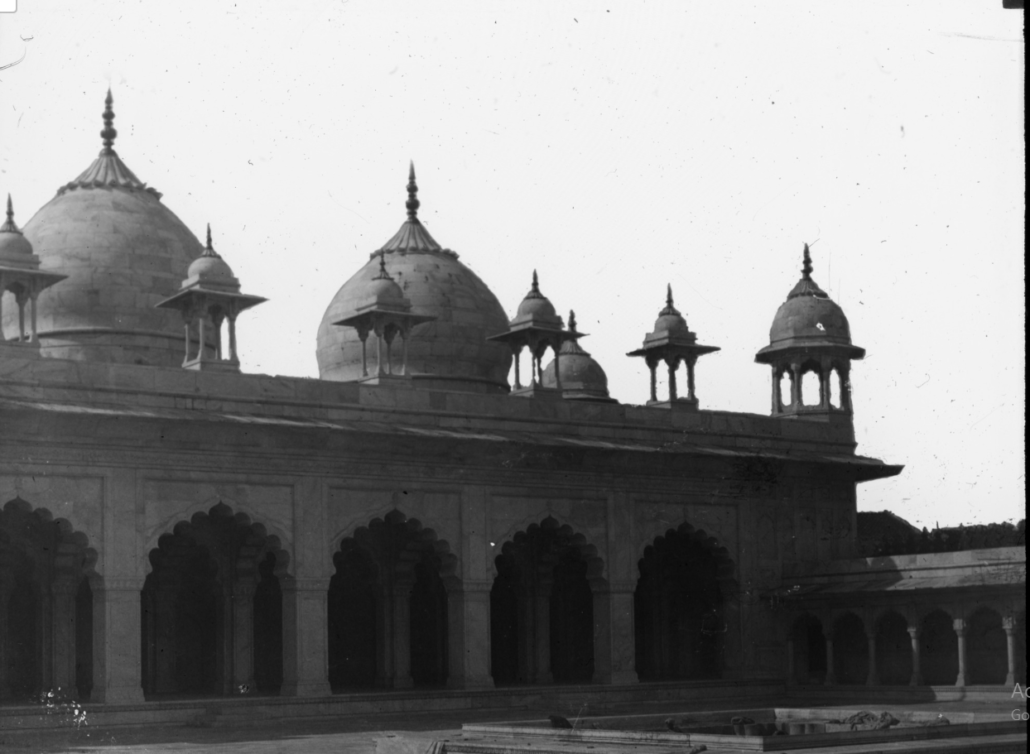Part-1 Coping and Plinths
Plate -1 | Plate 2 | Plate 3 | Plate 4 | Plate 5 | Plate 6 | Plate 7
Plate 8 : Coping from the Moti Masjid and Saman ( Musamman ) Burj at Agra
Coping from the Moti Masjid at Agra.
The Moti Masjid or Pearl Mosque at Agra, built of greyish-white marble, was erected by Shah Jahan in the fort of Agra, A.D. 1654. See Plate 17, fig. 3.


The Moti Masjid, also known as the Pearl Mosque, is a beautiful mosque located in Agra, India, within the complex of the Agra Fort. It is renowned for its stunning architecture and is built primarily of greyish-white marble, as you mentioned. Here is an overview of the architecture and features of the Moti Masjid:
- Architectural Style: The Moti Masjid is a fine example of Mughal architecture, which was prevalent during the rule of the Mughal Empire in India. It embodies the quintessential elements of Mughal design, characterized by a combination of Islamic, Persian, and Indian architectural styles.
- Marble Construction: The mosque is constructed predominantly from white marble, giving it the appearance of a glistening pearl, hence its name “Moti Masjid.”
- Three Domes: The Moti Masjid features three elegant bulbous domes with finials on top. These domes are one of the mosque’s most distinctive features and are reminiscent of Mughal architecture.
- Prayer Hall: The mosque has a spacious prayer hall with a large courtyard in front. The hall is adorned with intricately designed arches, columns, and a mihrab (a niche indicating the direction of Mecca for prayer).
- Decorative Elements: The Moti Masjid is known for its exquisite decorative elements, including intricate floral and geometric patterns carved into the marble. These delicate carvings are visible on the walls and ceilings, enhancing the mosque’s aesthetic appeal.
- Staircase and Minarets: A marble staircase leads to the main entrance of the mosque. The mosque also has two slender minarets on either side of the prayer hall, which adds to its overall elegance.
- Open Courtyard: In front of the prayer hall, there is an open courtyard where worshippers gather for prayer. The white marble flooring of the courtyard complements the mosque’s overall design.
- Symmetrical Design: The Moti Masjid is known for its symmetrical layout and balanced proportions, which are typical of Mughal architecture.
Coping From the Saman ( Musamman ) Burj at Agra.
Saman (Jasmine) or Musamman Burj in the fort of Agra adjoining the eastern wall of the Khwab-gah, was probably erected in between 1631–40. See Plates 14, fig. 1; 15, fig. 3, and 35, fig. 2.

Musamman Burj is a UNESCO World Heritage site in Agra, India. This architectural marvel is a prime example of Mughal architecture, showcasing the distinctive elements of the era. Here’s an overview of the architectural style and features of Musamman Burj:
- Mughal Architecture: Musamman Burj exemplifies Mughal architectural style, characterized by a blend of Persian, Indian, and Islamic architectural elements. This style is noted for its grandeur, symmetry, and use of white marble.
- Marble Construction: The primary building material used in the construction of Musamman Burj is white marble. The use of white marble is a hallmark of Mughal architecture and gives the structure a pristine and elegant appearance. The decoration of the walls is pietra dura.
- Jali (Lattice Work): Musamman Burj features intricate jali work, or lattice screens, that adorn the windows and openings. These screens are delicately carved with floral and geometric patterns, allowing light and air to filter through while providing privacy.
- Octagonal Tower: Musamman Burj is an octagonal tower, which is a unique architectural feature. It stands out among the predominantly rectangular and square structures within the Agra Fort. This tower is crowned with a chhatri (dome-shaped pavilion) and is set on a raised platform.
- Chhatris (Pavilions): The chhatris atop Musamman Burj are an iconic feature of Mughal architecture. They are small, domed pavilions with decorative finials, adding to the aesthetic appeal of the structure. The chhatris provide shade and a place to sit while enjoying the view.
- Riverfront Location: Musamman Burj offers panoramic views of the Yamuna River and the Taj Mahal, which is located on the opposite bank. The location was chosen for its strategic and aesthetic value. It is here that Shah Jahan along with his favorite daughter Jahanara Begum had spent his last few years as a captive of his son Aurangzeb.
- Agra Fort Integration: Musamman Burj is part of the larger Agra Fort complex, and its architecture seamlessly integrates with the fort’s defensive and palatial structures. It served as a private residence for the Mughal emperor Shah Jahan during his later years, adding a personal touch to the fort’s architectural ensemble.
- Intricate Carvings: The marble facade of Musamman Burj is adorned with intricate carvings and inlay work, including floral motifs and Quranic inscriptions.
Home page of Jeypore portfolio of architecture details
Part-1 Coping and Plinths
9 thoughts on “Jeypore portfolio Part-1 Plate-8”